Summer in the City of London Gloria Rediscovers The Royal Botanic Gardens, Kew
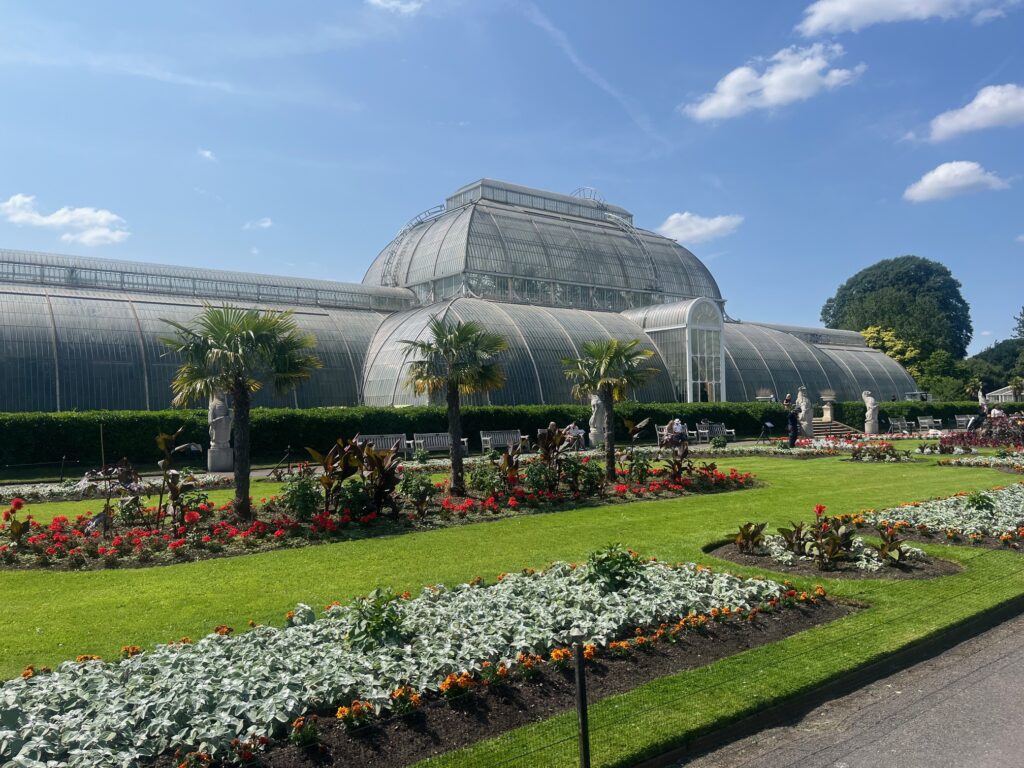
It has been many years since I last visited The Royal Botanic Gardens, Kew, usually simply referred to as Kew Gardens. It is a wonderful place to go, especially on a summer’s day in London. Spanning over 300 acres and serving not only as a place of immense natural beauty but also as a global leader in plant science, conservation, and education. With its rich history, diverse plant collections, and commitment to safeguarding the future of plants, it’s a truly unique place to visit and one I thought I should rediscover.
I last visited The Royal Botanic Gardens, Kew, usually simply referred to as Kew Gardens. It is a wonderful place to go, especially on a summer’s day in London. Spanning over 300 acres and serving not only as a place of immense natural beauty but also as a global leader in plant science, conservation, and education. With its rich history, diverse plant collections, and commitment to safeguarding the future of plants, it’s a truly unique place to visit and one I thought I should rediscover.
Kew Gardens’ dates back to 1759 when it was created as a royal garden for Augusta the Princess of Wales. Later in 1840 Queen Victoria endorsed the decision to transform Kew from a royal pleasure place into a public park,on the understanding that it would also be used as a scientific institution dedicated to botanical research. Sir William Hooker was then appointed its first official Director and during his time there the gardens grew in size. Many glasshouses were constructed including the iconic Palm House, the building most people associate with Kew. A masterpiece of Victorian engineering, it is made of wrought iron and glass and inside designed to replicate a rainforest environment. Visitors can experience a vast array of tropical plants. By climbing the spiral staircases you can get an even closer view of varieties of exotic plants including towering palms,banana trees, orchids and rare ferns. The humidity and warmth create an immersive experience that feels like stepping into another world.
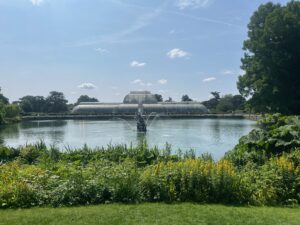 More orchids can be found within The Princess of Wales Conservatory, opened in 1987 by Princess Diana. As well as orchids it’s home to vast array of plants, including cacti and even carnivorous species like Venus flytraps.I remembered it from an earlier visit some years ago although this visit time I have to say the conservatory was outshone by the Waterlily House smaller but stunningly beautiful this was a new discovery for me only found because we had been able to explore more of the gardens via the Kew Explorer.
More orchids can be found within The Princess of Wales Conservatory, opened in 1987 by Princess Diana. As well as orchids it’s home to vast array of plants, including cacti and even carnivorous species like Venus flytraps.I remembered it from an earlier visit some years ago although this visit time I have to say the conservatory was outshone by the Waterlily House smaller but stunningly beautiful this was a new discovery for me only found because we had been able to explore more of the gardens via the Kew Explorer.
The Kew explorer costs £6.50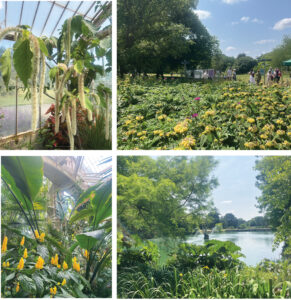 for adults and £2.50 for children and is very well worth the ticket price. With it you are really able to appreciate the actual size of Kew and the parts it would take far too long to walk to. For example the impressive Redwood trees area.rare and endangered species and the famous and majestic Kew oaks. In fact there are more than 14.000 trees here from over 2,000 different species. There is also a tour guide on the explorer to alert you to amazing facts like the fact that around 90% of the world’s entire plant species can be found in Kew Gardens. Home to one of the most diverse plant collections on Earth, with over 50,000 living plants spread across its vast landscape, glasshouses and gardens, the specimens here represent nearly every corner of the globe.
for adults and £2.50 for children and is very well worth the ticket price. With it you are really able to appreciate the actual size of Kew and the parts it would take far too long to walk to. For example the impressive Redwood trees area.rare and endangered species and the famous and majestic Kew oaks. In fact there are more than 14.000 trees here from over 2,000 different species. There is also a tour guide on the explorer to alert you to amazing facts like the fact that around 90% of the world’s entire plant species can be found in Kew Gardens. Home to one of the most diverse plant collections on Earth, with over 50,000 living plants spread across its vast landscape, glasshouses and gardens, the specimens here represent nearly every corner of the globe.
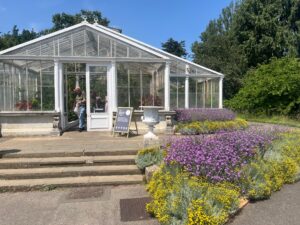 Today, Kew is not only a UNESCO World Heritage Site that inspires millions of visitors annually, it is also a major global centre for scientific research and plant conservation. The Kew Science department employs hundreds of botanists, mycologists, and researchers who work to discover, catalogue, and conserve plant diversity.Kew’s Herbarium houses over 7 million preserved plant specimens and is one of the largest and most comprehensive collections in the world. These specimens, some dating back centuries, are used by scientists around the globe to identify plant species, study biodiversity, and track ecological changes over time.The library and archives are similarly impressive, containing more than 750,000 volumes and thousands of botanical illustrations, maps, and manuscripts.
Today, Kew is not only a UNESCO World Heritage Site that inspires millions of visitors annually, it is also a major global centre for scientific research and plant conservation. The Kew Science department employs hundreds of botanists, mycologists, and researchers who work to discover, catalogue, and conserve plant diversity.Kew’s Herbarium houses over 7 million preserved plant specimens and is one of the largest and most comprehensive collections in the world. These specimens, some dating back centuries, are used by scientists around the globe to identify plant species, study biodiversity, and track ecological changes over time.The library and archives are similarly impressive, containing more than 750,000 volumes and thousands of botanical illustrations, maps, and manuscripts.
Kew is deeply committed to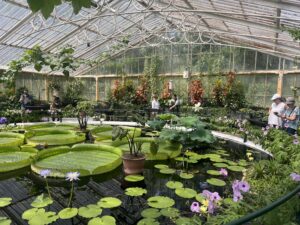 educating the public about the importance of plants and the need to protect them. Exhibitions, guided tours, seasonal festivals, and art installations further engage visitors, helping to raise awareness about critical issues such as climate change, deforestation, and biodiversity loss.As a leading authority in botany, it collaborates with more than 100 countries to support sustainable development, protect endangered species, and train future plant scientists. Its work supports the UN’s Sustainable Development Goals, particularly those related to climate action, life on land, and food security.
educating the public about the importance of plants and the need to protect them. Exhibitions, guided tours, seasonal festivals, and art installations further engage visitors, helping to raise awareness about critical issues such as climate change, deforestation, and biodiversity loss.As a leading authority in botany, it collaborates with more than 100 countries to support sustainable development, protect endangered species, and train future plant scientists. Its work supports the UN’s Sustainable Development Goals, particularly those related to climate action, life on land, and food security.
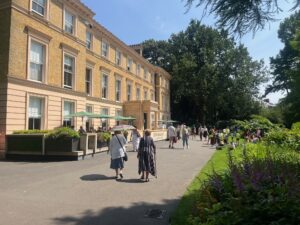 So if you are travelling to London remember that Summer brings Kew gardens into full bloom with colorful borders, lush lawns and so much to see and do. Easily accessible by just a short walk from the Kew Gardens Tube Station on the District line it offers a peaceful escape from the hustle and bustle of the city and is both an enriching and rejuvenating experience.
So if you are travelling to London remember that Summer brings Kew gardens into full bloom with colorful borders, lush lawns and so much to see and do. Easily accessible by just a short walk from the Kew Gardens Tube Station on the District line it offers a peaceful escape from the hustle and bustle of the city and is both an enriching and rejuvenating experience.
